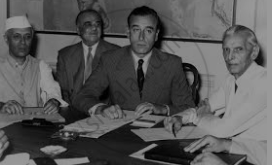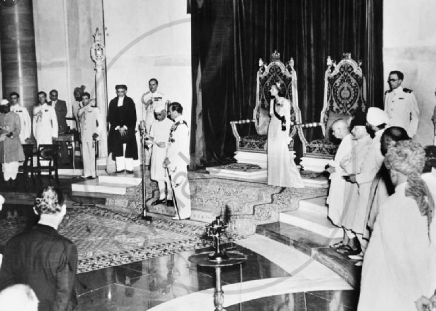Advertisements
Online Mock Tests
Chapters
2: The Executive (President and Vice-President)
3: The Prime Minister and The Council of Ministers
4: The Union Judiciary (The Supreme Court)
5: The State Judiciary (The High Court)
6: The State Judiciary (The Subordinate Courts)
7: First War of Independence: 1857
8: The Rise of Nationalism and Foundation of the Indian National Congress
9: The Programme and Achievements of the Early Nationalist
10: Rise of Assertive Nationalism
11: The Partition of Bengal
12: Formation of the Muslim League
13: The National Movement During the First World War (1915-1919)
14: Mahatma Gandhi & The National Movement (1919-1934)
15: Events Leading to the Quit India Movement (1935-1943)
16: Subhash Chandra Bose and the I.N.A
▶ 17: Towards Partition of India (1944-1947)
18: World War-I and Treaty of Versailles
19: Rise of Dictatorship and The Second World War
20: The United Nations (Origin and Purpose)
21: The United Nations Principal Organs – Composition and Functions
22: The United Nations (Major Agencies – Their Functions)
23: Universal Declaration of Human Rights
24: Non-Aligned Movement
![ICSE solutions for History and Civics [English] Class 10 ICSE chapter 17 - Towards Partition of India (1944-1947) ICSE solutions for History and Civics [English] Class 10 ICSE chapter 17 - Towards Partition of India (1944-1947) - Shaalaa.com](/images/history-and-civics-english-class-10-icse_6:5f2b1b2038084cf381bfa42c826a928c.jpg)
Advertisements
Solutions for Chapter 17: Towards Partition of India (1944-1947)
Below listed, you can find solutions for Chapter 17 of CISCE ICSE for History and Civics [English] Class 10 ICSE.
ICSE solutions for History and Civics [English] Class 10 ICSE 17 Towards Partition of India (1944-1947) Very Short Questions
Name the members of the Cabinet Mission Plan.
What was the purpose of the Cabinet Mission?
In what way did the Cabinet Mission Plan try to preserve the unity of India?
What was finally accepted in the Cabinet Mission Plan by the Congress?
What was finally accepted in the Cabinet Mission Plan by the Muslim League?
Who refuse to implement the Interim Government Plan as proposed in the Cabinet Mission Plan?
Which day was observed as the Direct Action Day by the League?
What is said about Princely States in Mountbatten Plan?
What were the views of the Sikhs and Scheduled Castes on the proposals of the Cabinet Mission Plan?
What is stated about the Princely States in the Indian Independence Act 1947?
To whom was the power to be transferred according to the Mountbatten Plan?
What last effort did Gandhiji make in order to prevent the partition of the country?
Who was elected as the President of the Constituent Assembly in 1946?
Who replaced Lord Wavell as the Viceroy of India?
Or
Name the last British Viceroy of India.
What were the views of the, Congress on partition of the country?
ICSE solutions for History and Civics [English] Class 10 ICSE 17 Towards Partition of India (1944-1947) Short Questions I
In what way did the outcome of the general elections in 1945-46 strengthen Jinnah’s demand for partition?
Mention two proposals of the Wavell’s Plan.
What was the reaction of Muslim League on the proposal of Lord Wavell.
On what grounds did the Cabinet Mission reject Jinnah’s demand for partition of India?
Give any two salient features of the Cabinet Mission Plan.
What was the view of the Congress and Muslim League on the grouping of the provinces as proposed in the Cabinet Mission Plan?
What were the recommendations of the Cabinet Mission Plan regarding the Princely States?
What was mentioned in the Cabinet Mission Plan regarding provincial Autonomy?
Why did the Congress reject the League’s claim of having the exclusive right for nominating members of the Muslim quota in the Interim Government?
What is referred to as the ‘Great Calcutta Killing’?
How did Jinnah justify his stand to resort to ‘Direct Action’?
What were the two proposals related to the Princely states in the Mountbatten Plan.
How were the borders of the two new Dominions to be demarcated according to the Indian Independence Act of 1947?
State any two reasons to justify why the Congress accepted the Mountbatten Plan?
ICSE solutions for History and Civics [English] Class 10 ICSE 17 Towards Partition of India (1944-1947) Short Questions II
What was the reaction of the Congress to the Wavell’s plan.
Give the reasons for the Muslim League’s acceptance and later rejection of the Cabinet Mission plan.
Why did the Cabinet Mission Plan reject the demand for Pakistan?
In terms of the Independence Act of 1947 Bengal and Punjab were also to be divided If the people so desired. In this connection explain what was done to determine the choice of the people.
Why the Muslim League earlier rejected and later participated in Interim Government.
The Muslim League decided to observe the Direct Action Day on 16th August, 1946. In this context briefly discuss about its result.
By pursuing Direct Action Plan, the Muslim League resorted to violent activities. Discuss.
What did congress leaders do when the Muslim League resorted to violent activities after pursuing Direct Action plan. How worst was the communal violence?
Describe briefly the events that led to Mr. Clement Attlee’s announcement of 20th February, 1947. With reference to this brief about the formation of Interim Government by the Congress on 2nd September, 1946.
Prime Minister Attlee’s announcement on February 20, 1947, was attempted to end the deadlock in India and marked the last fe w months of British Rule. In this context write short notes on Attlee’s announcement of 20th February, 1947.
Or
Mention any three salient features of the Atlee’s announcement.
What was the place of Princely States in Mountbatten Plan.
How were the people of Punjab and Bengal affected by the communal riots?
In reference to the Indian Independence Act of 1947, discuss what happened to Princely States.
What was achieved by this ‘Treaty’of Peace without War’?
Lord Samuel described the Indian Independence Act as Treaty of Peace without War’. In this connection state why did Lord Samuel say so?
ICSE solutions for History and Civics [English] Class 10 ICSE 17 Towards Partition of India (1944-1947) Picture Based Questions
With reference to the picture given answer the following:
(i) Identify the Viceroy in the picture.
(ii) Why was he sent to India?
With reference to the picture given answer the following:
(i) Identify the event in the above picture. Name the lady seen in the given picture.
(ii) Mention the year when the event took place.
In the above historic photograph, Pandit Jawaharlal Nehru is seen giving his famous speech in the Constituent Assembly on August 14, 1947. In this context, mention the Provisions of the Indian Independence Act of 1947 regarding the Constituent Assemblies.
ICSE solutions for History and Civics [English] Class 10 ICSE 17 Towards Partition of India (1944-1947) Long Questions
Mention any three proposals of the Cabinet Mission.
What was the reactions of the Congress to the Cabinet Mission Plan.
After the termination of the Second World War the freedom movement entered a new phase. In this context briefly describe the proposals of Lord Wavell.
The Mountbatten Plan of June 3, 1947, was accepted by ad parties. What were the Four salient features of the Mountbatten Plan.
Mention four important reasons for the All India Congress Committee accepting the Mountbatten Plan.
All parties accepted the Mountbatten Plan of 3rd June, 1947. In this context briefly explain the basis of the partition.
Why did the Muslim League observe the Direct Action Day?
What were the main provisions of the Indian Independence Act?
What were the factors which were responsible for the creation of Pakistan?
How did Lord Mountbatten planned to solve the communal problem existing in India?
Mention the reasons that‘made the Congress accept the Partition Proposals.
Solutions for 17: Towards Partition of India (1944-1947)
![ICSE solutions for History and Civics [English] Class 10 ICSE chapter 17 - Towards Partition of India (1944-1947) ICSE solutions for History and Civics [English] Class 10 ICSE chapter 17 - Towards Partition of India (1944-1947) - Shaalaa.com](/images/history-and-civics-english-class-10-icse_6:5f2b1b2038084cf381bfa42c826a928c.jpg)
ICSE solutions for History and Civics [English] Class 10 ICSE chapter 17 - Towards Partition of India (1944-1947)
Shaalaa.com has the CISCE Mathematics History and Civics [English] Class 10 ICSE CISCE solutions in a manner that help students grasp basic concepts better and faster. The detailed, step-by-step solutions will help you understand the concepts better and clarify any confusion. ICSE solutions for Mathematics History and Civics [English] Class 10 ICSE CISCE 17 (Towards Partition of India (1944-1947)) include all questions with answers and detailed explanations. This will clear students' doubts about questions and improve their application skills while preparing for board exams.
Further, we at Shaalaa.com provide such solutions so students can prepare for written exams. ICSE textbook solutions can be a core help for self-study and provide excellent self-help guidance for students.
Concepts covered in History and Civics [English] Class 10 ICSE chapter 17 Towards Partition of India (1944-1947) are Clauses of Cabinet Mission Plan, Mountbatten Plan (Clauses and Its Acceptance), Indian Independence Act of 1947, Independence by an Act of Legislation, Events that Led to the Cabinet Mission, Cabinet Mission in India, Rejection of the Demand for Pakistan, Reaction to the Cabinet Mission Plan, Conflict Between Congress and Muslim League.
Using ICSE History and Civics [English] Class 10 ICSE solutions Towards Partition of India (1944-1947) exercise by students is an easy way to prepare for the exams, as they involve solutions arranged chapter-wise and also page-wise. The questions involved in ICSE Solutions are essential questions that can be asked in the final exam. Maximum CISCE History and Civics [English] Class 10 ICSE students prefer ICSE Textbook Solutions to score more in exams.
Get the free view of Chapter 17, Towards Partition of India (1944-1947) History and Civics [English] Class 10 ICSE additional questions for Mathematics History and Civics [English] Class 10 ICSE CISCE, and you can use Shaalaa.com to keep it handy for your exam preparation.
